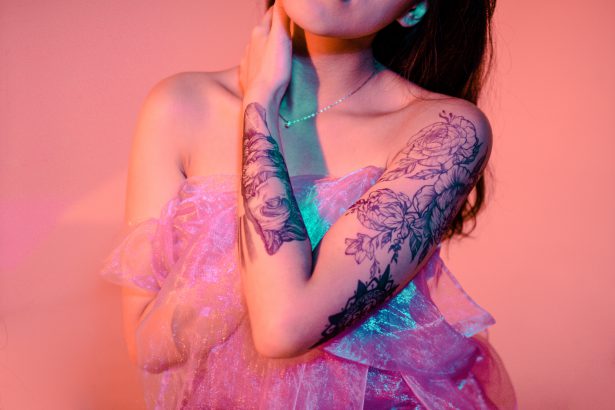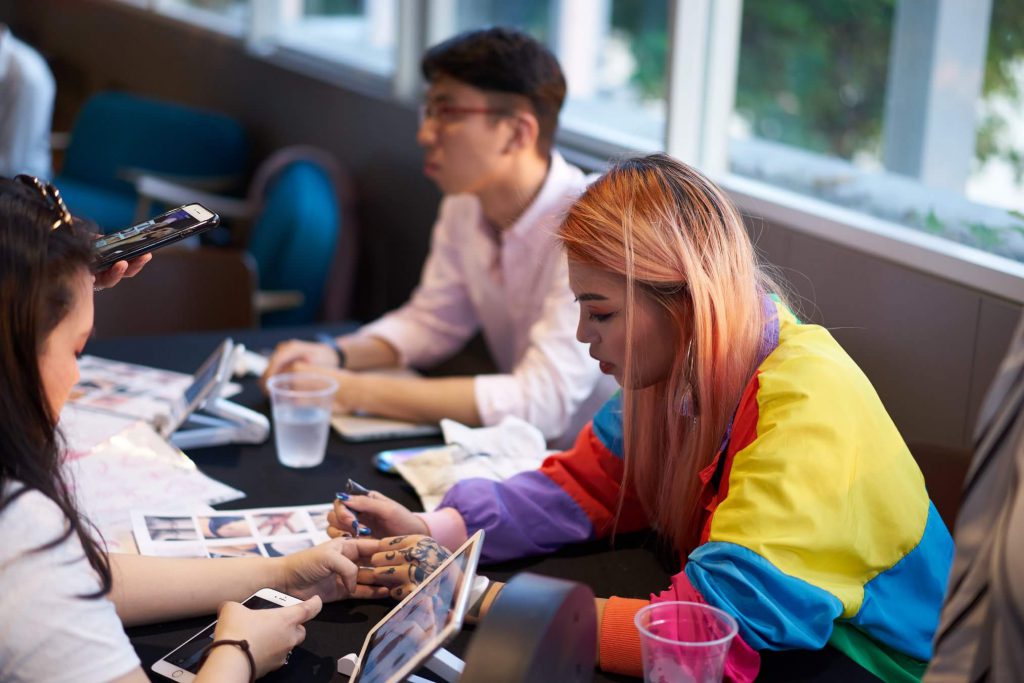Fruit Juice Tattoos? Discovering the art of 'jagua body art' with Henndrawn
mis à jour le 12 July 2018 à 11:43
What is 'jagua body art'? We sat down with See Min from Henndrawn, who is pioneering jagua body art Singapore
Tattoos. At some point in our life, we've all toyed with the idea of getting this beautiful art etched onto our skin.
Unfortunately, there are some downsides to getting a permanent tattoo: social stigma in Asian culture; taking that big leap of faith of getting something permanently etched; pain and needles, just to name a few. But did you know that now you can get nearly the exact same kind of art without technically getting one right here in Singapore?
Say hello to Jagua body art - body art created from the blue juice of the jagua fruit. The result? A non-permanent tattoo that looks exactly like one.
From fierce wolves to delicate flowers (and get this: even a portrait of the late Lee Kuan Yew!), See Min, the artist behind the Singapore-based Henndrawn, uses jagua body art to let her clients experience the fun of getting a tattoo without the pain and permanence. We sat down with See Min to get a glimpse into what exactly jagua body art entails, and her journey of becoming the pioneer of jagua art in Singapore.
Note: Answers have been slightly edited for clarity.
MFA: Tell us a little bit about yourself. How and why did you get yourself into the art of professional inking?
See Min: Since I was young, art has always been a way for me to escape from academics. I started body art as a side hobby; I had never intended Henndrawn to be a full-blown business.
I first got into body art myself when I got my henna done. I really liked it, and I realized that perhaps if I did it myself, then I wouldn’t have to spend so much money on it. I started sharing my designs on my personal Instagram, and as my art spread via word of mouth, people started to engage me in job offers. It was only when I booked my first corporate event offer that I realized that perhaps Henndrawn could actually become a brand.

Photo: Henndrawn
MFA: Tell us about the brand Henndrawn. How did this journey of pioneering jagua body art in Singapore begin for you?
See Min: I started Henndrawn when I was in my first year at university. In the beginning, I couldn’t do it full time as I was juggling my hectic college life, and my part-time jobs as a waitress and a tuition teacher.
I started using jagua because I started to want to replicate tattoos the best I could. My mother did not allow me to get tattoos, so I started using jagua as a way to be tattooed without technically defying her wishes. I first tried to mimic tattoos with the henna I had at hand, but it just wasn’t what I wanted: the colour was off, and I could not shade or do very complicated designs.
I found out about jagua online. Even though I knew almost nothing about it initially, I imported the ink, and from there, worked hard to make sure that all my jagua designs resembled tattoos as closely as possible. I am proud to be the first few in the world to use jagua specifically to imitate tattoos. Basically, Henndrawn is really what I myself need, and what I wished I had growing up.
MFA: What exactly is jagua body art? What are the materials you use, and how do you apply it to your customers’ skins?
See Min: Jagua body art is traditional body art created from the jagua gel, a gel made out of pasteurized jagua juice from the jagua fruit. The fruit, called Genipa americana, is native to South America, and I import it from an online distributor who actually goes to the forest himself to pick the fruits. After I buy the gel, I repackage it into small triangular cones (similar to the ones used to apply henna), and I apply it by squeezing the gel onto my customers’ skins.
MFA: What is the difference between henna and jagua?
See Min: They are two essentially very different things because they are made from very different ingredients. Henna is made from the leaves of the henna plant, and the paste is made from the crushed powder of the leaves, which is then mixed with essential oils, water, and lemon juice.
Jagua is different. The gel is made from the juice of the jagua plant, essential oils, and xanthan gum. This also means that the two have very different consistencies. Because jagua is a translucent gel, it's possible to achieve more tones in gradient shading. You cannot do that with Henna because it is a thick paste.
There is also a big difference in the color. Henna stains your skin a reddish brown or brownish green, while jagua stains it a tattoo blue or blue-black.
MFA: Why did you choose to do jagua body art instead of professional tattooing?
See Min: I’d actually always wanted to be a tattoo artist. Because I had never taken proper art classes before, I had always thought that I was not qualified or good enough. Which is why I've never dared to ask any tattoo artist to let me shadow them.
Even though I am more confident in my skills now, I haven't switched to tattooing because as a pioneer of jagua body art in Singapore, I feel like I am responsible for this industry and nurture artists. So that perhaps one day, there will be artists who can put their own style and spin onto jagua art, just like in the tattoo industry.
MFA: Why should people choose jagua body art over tattooing?
See Min: I have no qualms about people choosing tattoos over jagua body art. My target audience is people who are afraid to go for the real thing. Some of my clients come to me to “try out” a design before they go for a permanent tattoo, and others come to my service so that they can get something new every time.
I was actually speaking to a friend who is also a professional tattooist, and we realized that there is no direct competition between jagua and tattoo artists because we serve completely different audiences. People who get tattoos have a different appreciation for the art -- they appreciate the beauty of the pain and the permanence, but for jagua, it is all about having fun!
MFA: What is the most fulfilling experience you’ve had as a body artist?
See Min: I once did jagua body art on a woman who had a mastectomy. I will never know fully how my work affected her, but I realized that I was part of the healing process for my client and that my work could do so much. I also found out that after our appointment, she decided to get a real tattoo. I was able to make an impact, and for that, my job is done.
MFA: Talk about your vision of destigmatizing body art.
See Min: My vision of destigmatizing body art in Singapore through Henndrawn came a little later. After speaking with my clients, I realized that many people in Singapore face the dilemma same dilemma that I did: of wanting a tattoo, but not being able to because of underlying social stigma faced at work or in their personal lives.
One day, I thought to myself: “What if everyone was walking around in jagua tattoos? Would the stigma still be there?” Nobody would be able to differentiate a fake tattoo from a real one. It is still my dream that I could contribute to the destigmatization of body art, both fake and real.
MFA: It seems like you are very active on your social media and even do personal shout-outs and replies to Instagram DMs yourself. What is your relationship with your customers?
See Min: Henndrawn is very much me in the sense that I’m the one behind the Instagram account and I’m the one who, most of the time, takes clients. I am able to get to know my clients very closely through our conversations while I do my art, and in fact, a lot of them actually eventually become my personal friends. My relationship with my clients and my Instagram followers is quite special and personal, and I appreciate the fact that they like me for my art and not for other superficial reasons.
MFA: What are some long and short-term goals you have for Henndrawn?
See Min: One short-term goal I’ve been working on is to get Henndrawn to work at Coachella! I already shot the photos for it, all I need to do now is to craft and send the media kit to them and beg them to fly us out California.
As part of my dream of destigmatizing body art in Singapore, I have started teaching jagua body art in workshop classes so that other artists can start up their own studios or hobbies. Right now, I’m starting to have my artists hold appointments without me so that I can take a step back and focus on teaching and working to expand Henndrawn instead.
You can book a slot for an appointment with Henndrawn here, and check out her designs on Instagram at @henn.drawn.
Kanako Sugawara
READ MORE:
Not Your Usual Travel Guide: 10 Alternative experiences to try in Singapore
Ink 101: 5 Things to consider as a working professional before you get a tattoo
8 Important questions to ask yourself before you get a tattoo



